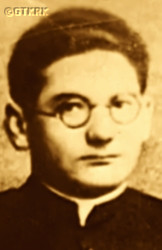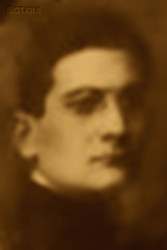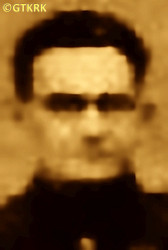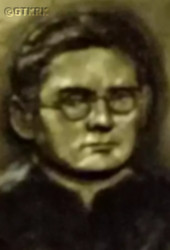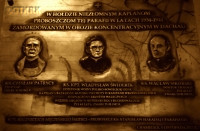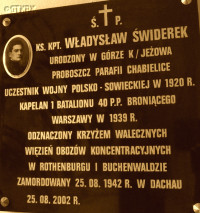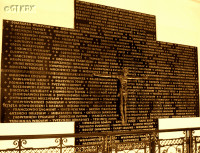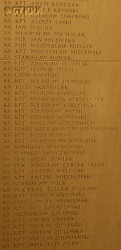Roman Catholic
St Sigismund parish
05-507 Słomczyn
85 Wiślana Str.
Konstancin deanery
Warsaw archdiocese, Poland
full list:
displayClick to display full list

searchClick to search full list by categories
wyświetlKliknij by wyświetlić pełną listę po polsku

szukajKliknij by przeszukać listę wg kategorii po polsku

Martyrology of the clergy — Poland
XX century (1914 – 1989)
personal data
surname
ŚWIDEREK
forename(s)
Vladislav (pl. Władysław)
function
diocesan priest
creed
Latin (Roman Catholic) Church RCmore on
en.wikipedia.org
[access: 2014.09.21]
diocese / province
Łódź diocesemore on
en.wikipedia.org
[access: 2013.05.19]
Warsaw archdiocesemore on
en.wikipedia.org
[access: 2013.05.19]
RC Military Ordinariate of Polandmore on
en.wikipedia.org
[access: 2014.12.20]
honorary titles
„Cross of Valour”more on
„Cross of Valour”
date and place
of death
25.08.1942

KL Dachauconcentration camp
today: Dachau, Upper Bavaria reg., Bavaria state, Germany
more on
en.wikipedia.org
[access: 2016.05.30]
alt. dates and places
of death
23.06.1942
details of death
Volunteer in Polish–Russian war of 1920.
After the German invasion of Poland on 01.09.1939 (the Russians attacked 17 days later) and the beginning of World War II, during the September Campaign, left his parish village and reached Warsaw. May have traveled with a crowd of refugees, or perhaps with one of the units of the 30th Polesye Infantry Division — his parish Chabielice was on one of the main axes of the German attack, defended by that Division, which, retreating under German pressure, passed through Chabielice on 03.09.1939. On 13.09.1939, the Division reached the vicinity of Warsaw and it is possible that found himself in Warsaw's Wola district at that time.
During Warsaw siege, serving as a chaplain–volunteer of 1st Battalion of 40th „Lviv Children” Infantry Regiment of the Polish Army, took over command of the battalion after its commander got wounded and successfully defended against attacking Germans.
Wounded on 18.09.1939.
Arrested by the Germans after Warsaw fall on 28.09.1939.
Interned in POW camps, such as Oflag IX C Rotenburg an der Fulda.
From there on 18.04.1940, in contravention of Geneva conventions of 27.07.1929, transported to KL Buchenwald concentration camp.
Finally on 06‐07.07.1942 moved to KL Dachau concentration camp where perished.
According to the death certificate, prepared in KL Dachau, the „honest” otherwise German „medical doctors” and formalists — and at the same time, unrivaled fairy tale spinners — noted that the cause of death was Germ. „Versagen von Herz und Kreislauf, bei Phlegmone am rechten Fuß” (Eng. „Heart and circulatory failure, due to phlegmon of the right foot”).
alt. details of death
According to other versions, was a chaplain of the Polish Army reserve and was mobilized in 08.1939. Was to serve in field hospital No. 602, which was to be manned by the staff of the District Hospital of the District Corps OK No. VI Lviv. However, did not reach Lviv. Perhaps on the way came into contact with the 40th Infantry Regiment, which also — when leaving the mobilization site in Lviv for Włocławek — did not reach the concentration site due to German air attacks, instead making it to Warsaw.
prisoner camp's numbers
31228Click to display source page (KL DachauClick to display the description), 670Click to display source page (KL BuchenwaldClick to display the description)
cause of death
extermination: exhaustion and starvation
perpetrators
Germans
sites and events
KL DachauClick to display the description, KL BuchenwaldClick to display the description, Oflag IX C Rotenburg an der FuldaClick to display the description, Ribbentrop‐MolotovClick to display the description, Pius XI's encyclicalsClick to display the description, Polish‐Russian war of 1919‐1921Click to display the description
date and place
of birth
13.06.1898Birth certification on:
photos.szukajwarchiwach.gov.pl
[access: 2025.03.15]

Góratoday: Jeżów gm., Brzeziny pov., Łódź voiv., Poland
more on
en.wikipedia.org
[access: 2021.10.09]
parents
ŚWIDEREK Andrew
🞲 ?, ? — 🕆 ?, ?

SKOWROŃSKA Francesca
🞲 ?, ? — 🕆 ?, ?
baptism
13.06.1898Birth certification on:
photos.szukajwarchiwach.gov.pl
[access: 2025.03.15]

Jeżówtoday: Jeżów gm., Brzeziny pov., Łódź voiv., Poland
more on
en.wikipedia.org
[access: 2020.11.27]
St Andrew the Apostle RC church
presbyter (holy orders)
ordination
15.03.1924

Łódźtoday: Łódź city pov., Łódź voiv., Poland
more on
en.wikipedia.org
[access: 2021.07.18]
positions held
1938 – 1939
parish priest — Chabielicetoday: Szczerców gm., Bełchatów pov., Łódź voiv., Poland
more on
en.wikipedia.org
[access: 2021.12.18] ⋄ St Michael the Archangel RC parish ⋄ Bełchatówtoday: Bełchatów urban gm., Bełchatów pov., Łódź voiv., Poland
more on
en.wikipedia.org
[access: 2021.12.18] RC deanery
1931 – 1938
parish priest — Suchcicetoday: Drużbice gm., Bełchatów pov., Łódź voiv., Poland
more on
en.wikipedia.org
[access: 2021.12.18] ⋄ St Ignatius Loyola RC parish ⋄ Bełchatówtoday: Bełchatów urban gm., Bełchatów pov., Łódź voiv., Poland
more on
en.wikipedia.org
[access: 2021.12.18] RC deanery
1930 – 1931
parish priest — Budzynektoday: Dalików gm., Poddębice pov., Łódź voiv., Poland
more on
en.wikipedia.org
[access: 2021.12.18] ⋄ Beheading of St John the Baptist and the Holy Trinity RC parish ⋄ Ozorkówtoday: Ozorków urban gm., Zgierz pov., Łódź voiv., Poland
more on
en.wikipedia.org
[access: 2020.11.20] RC deanery
1929 – 1930
chaplain — Łódźtoday: Łódź city pov., Łódź voiv., Poland
more on
en.wikipedia.org
[access: 2021.07.18] ⋄ St Alexander Hospital for the Poor (at 115 Aleksandrowska Str.)
1929 – 1930
prefect — Łódźtoday: Łódź city pov., Łódź voiv., Poland
more on
en.wikipedia.org
[access: 2021.07.18] ⋄ primary schools ⋄ Łódźtoday: Łódź city pov., Łódź voiv., Poland
more on
en.wikipedia.org
[access: 2021.07.18] RC deanery
1927 – 1929
vicar — Dłutówtoday: Dłutów gm., Pabianice pov., Łódź voiv., Poland
more on
en.wikipedia.org
[access: 2020.11.01] ⋄ St Three Kings RC parish ⋄ Pabianicetoday: Pabianice urban gm., Pabianice pov., Łódź voiv., Poland
more on
en.wikipedia.org
[access: 2021.12.18] RC deanery — also: prefect of elementary schools
1926 – 1927
vicar — Łódźtoday: Łódź city pov., Łódź voiv., Poland
more on
en.wikipedia.org
[access: 2021.07.18] ⋄ Transfiguration of the Lord RC parish ⋄ Łódźtoday: Łódź city pov., Łódź voiv., Poland
more on
en.wikipedia.org
[access: 2021.07.18] RC deanery
1924 – 1926
vicar — Zgierztoday: Zgierz urban gm., Zgierz pov., Łódź voiv., Poland
more on
en.wikipedia.org
[access: 2021.12.18] ⋄ St Catherine of Alexandria the Virgin and Martyr RC parish ⋄ Zgierztoday: Zgierz urban gm., Zgierz pov., Łódź voiv., Poland
more on
en.wikipedia.org
[access: 2021.12.18] RC deanery
c. 1921 – 1924
student — Łódźtoday: Łódź city pov., Łódź voiv., Poland
more on
en.wikipedia.org
[access: 2021.07.18] ⋄ philosophy and theology, Theological Seminary
till c. 1919
student — Warsawtoday: Warsaw city pov., Masovia voiv., Poland
more on
en.wikipedia.org
[access: 2021.10.09] ⋄ philosophy and theology, Metropolitan Theological Seminary
others related
in death
BELONClick to display biography Zdislav Anthony, BRYDACKIClick to display biography Louis Cyprian, DACHTERAClick to display biography Francis, DRWALClick to display biography Francis, FRANCUZClick to display biography John, GÓRALIKClick to display biography John, JĘDRYSIKClick to display biography Severin (Fr Vincent Mary), KLARZAKClick to display biography Joseph, KRYŃSKIClick to display biography Adolph Bernard, LISSOWSKIClick to display biography Ceslav Joseph, MICHUŁKAClick to display biography John, MIEGOŃClick to display biography Vladislav, PATRYCYClick to display biography Ceslav Alexander, SIKORSKIClick to display biography Vaclav Steven, STOPCZAKClick to display biography Marian Conrad, SYPERClick to display biography Stanislav, SZABELSKIClick to display biography Edward Bronislav, TOMIAKClick to display biography Joseph, TRUSSClick to display biography Cyriac Boleslav, ZAKRZEWSKIClick to display biography John, ZIEMIAŃSKIClick to display biography Michael Urban, ZIĘBAClick to display biography Adalbert
sites and events
descriptions
KL Dachau: KL Dachau in German Bavaria, set up in 1933, became the main German Germ. Konzentrationslager (Eng. concentration camp) KL for Catholic priests and religious during World War II: On c. 09.11.1940, Reichsführer‐SS Heinrich Himmler, head of the SS, Gestapo and German police, as a result of the Vatican's intervention, decided to transfer all clergymen detained in various concentration camps to KL Dachau camp. The first major transports took place on 08.12.1940. In KL Dachau Germans held approx. 3,000 priests, including 1,800 Poles. The priests were forced to slave labor in the Germ. „Die Plantage” — the largest herb garden in Europe, managed by the genocidal SS, consisting of many greenhouses, laboratory buildings and arable land, where experiments with new natural medicines were conducted — for many hours, without breaks, without protective clothing, no food. They slaved in construction, e.g. of camp's crematorium. In the barracks ruled hunger, freezing cold in the winter and suffocating heat during the summer, especially acute in 1941‐1942. Prisoners suffered from bouts of illnesses, including tuberculosis. Many were victims of murderous „medical experiments” — in 11.1942 c. 20 were given phlegmon injections; in 07.1942 to 05.1944 c. 120 were used by for malaria experiments. More than 750 Polish clerics where murdered by the Germans, some brought to TA Hartheim euthanasia centre set up in Schloss Hartheim in Austria and murdered in gas chambers. At its peak KL Dachau concentration camps’ system had nearly 100 slave labour sub‐camps located throughout southern Germany and Austria. There were c. 32,000 documented deaths at the camp, and thousands perished without a trace. C. 10,000 of the 30,000 inmates were found sick at the time of liberation, on 29.04.1945, by the USA troops… (more on: www.kz-gedenkstaette-dachau.deClick to attempt to display webpage
[access: 2013.08.10], en.wikipedia.orgClick to attempt to display webpage
[access: 2016.05.30])
KL Buchenwald: In German Germ. Konzentrationslager (Eng. concentration camp) KL Buchenwald concentration camp, founded in 1937 and operational till 1945, Germans held c. 238,380 prisoners and murdered approx. 56,000 of them, among them thousands of Poles. Prisoners were victims of pseudo‐scientific experiments, conducted among others by Behring‐Werke from Marburg and Robert Koch Institute from Berlin companies. They slaved for Gustloff in Weimar and Fritz‐Sauckel companies manufacturing armaments. To support Erla‐Maschinenwerk GmbH in Leipzig, Junkers in Schönebeck (airplanes) and Rautal in Wernigerode Germans organized special sub‐camps. In 1945 there were more than 100 such sub‐camps. Dora concentration camp was initially one of them, as well as KL Ravensbrück sub‐camps (from 08.1944). On 08.04.1945 Polish prisoner, Mr Guido Damazyn, used clandestinely constructed short wave transmitter to sent, together with a Russian prisoner, a short message begging for help. It was received and he got a reply: „KZ Bu. Hold out. Rushing to your aid. Staff of Third Army” (American). Three days later the camp was liberated. (more on: www.buchenwald.deClick to attempt to display webpage
[access: 2013.08.10], en.wikipedia.orgClick to attempt to display webpage
[access: 2013.08.10])
Oflag IX C Rotenburg an der Fulda: German POW prisoner of war camp for officers in Rotenburg an der Fulda in Hesse. C. 60‐70 Polish Catholic priests, most of them military chaplains, captured by the Germans in 09.1939 during German invasion of Poland, were held POW there from 12.1939. In preparations for invasion of France all on 18.04.1940 were sent — in contravention of Geneva conventions of 27.07.1929 — to KL Buchenwald concentration camps. From 06.1940 Germ. Zweiglager (Eng. sub‐camp) of Oflag IX A/H Spangenberg and renamed Oflag IX A/Z. (more on: en.wikipedia.orgClick to attempt to display webpage
[access: 2019.11.17])
Ribbentrop‐Molotov: Genocidal Russian‐German alliance pact between Russian leader Joseph Stalin and German leader Adolf Hitler signed on 23.08.1939 in Moscow by respective foreign ministers, Mr. Vyacheslav Molotov for Russia and Joachim von Ribbentrop for Germany. The pact sanctioned and was the direct cause of joint Russian and German invasion of Poland and the outbreak of the World War II in 09.1939. In a political sense, the pact was an attempt to restore the status quo ante before 1914, with one exception, namely the „commercial” exchange of the so‐called „Kingdom of Poland”, which in 1914 was part of the Russian Empire, fore Eastern Galicia (today's western Ukraine), in 1914 belonging to the Austro‐Hungarian Empire. Galicia, including Lviv, was to be taken over by the Russians, the „Kingdom of Poland” — under the name of the General Governorate — Germany. The resultant „war was one of the greatest calamities and dramas of humanity in history, for two atheistic and anti‐Christian ideologies — national and international socialism — rejected God and His fifth Decalogue commandment: Thou shall not kill!” (Abp Stanislav Gądecki, 01.09.2019). The decisions taken — backed up by the betrayal of the formal allies of Poland, France and Germany, which on 12.09.1939, at a joint conference in Abbeville, decided not to provide aid to attacked Poland and not to take military action against Germany (a clear breach of treaty obligations with Poland) — were on 28.09.1939 slightly altered and made more precise when a treaty on „German‐Russian boundaries and friendship” was agreed by the same murderous signatories. One of its findings was establishment of spheres of influence in Central and Eastern Europe and in consequence IV partition of Poland. In one of its secret annexes agreed, that: „the Signatories will not tolerate on its respective territories any Polish propaganda that affects the territory of the other Side. On their respective territories they will suppress all such propaganda and inform each other of the measures taken to accomplish it”. The agreements resulted in a series of meeting between two genocidal organization representing both sides — German Gestapo and Russian NKVD when coordination of efforts to exterminate Polish intelligentsia and Polish leading classes (in Germany called «Intelligenzaktion», in Russia took the form of Katyń massacres) where discussed. Resulted in deaths of hundreds of thousands of Polish intelligentsia, including thousands of priests presented here, and tens of millions of ordinary people,. The results of this Russian‐German pact lasted till 1989 and are still in evidence even today. (more on: en.wikipedia.orgClick to attempt to display webpage
[access: 2015.09.30])
Pius XI's encyclicals: Facing the creation of two totalitarian systems in Europe, which seemed to compete with each other, though there were more similarities than contradictions between them, Pope Pius XI issued in 03.1937 (within 5 days) two encyclicals. In the „Mit brennender Sorge” (Eng. „With Burning Concern”) published on 14.03.1938, condemned the national socialism prevailing in Germany. The Pope wrote: „Whoever, following the old Germanic‐pre‐Christian beliefs, puts various impersonal fate in the place of a personal God, denies the wisdom of God and Providence […], whoever exalts earthly values: race or nation, or state, or state system, representatives of state power or other fundamental values of human society, […] and makes them the highest standard of all values, including religious ones, and idolizes them, this one […] is far from true faith in God and from a worldview corresponding to such faith”. On 19.03.1937, published „Divini Redemptoris” (Eng. „Divine Redeemer”), in which criticized Russian communism, dialectical materialism and the class struggle theory. The Pope wrote: „Communism deprives man of freedom, and therefore the spiritual basis of all life norms. It deprives the human person of all his dignity and any moral support with which he could resist the onslaught of blind passions […] This is the new gospel that Bolshevik and godless communism preaches as a message of salvation and redemption of humanity”… Pius XI demanded that the established human law be subjected to the natural law of God , recommended the implementation of the ideal of a Christian state and society, and called on Catholics to resist. Two years later, National Socialist Germany and Communist Russia came together and started World War II. (more on: www.vatican.vaClick to attempt to display webpage
[access: 2023.05.28], www.vatican.vaClick to attempt to display webpage
[access: 2023.05.28])
Polish‐Russian war of 1919‐1921: War for independence of Poland and its borders. Poland regained independence in 1918 but had to fight for its borders with former imperial powers, in particular Russia. Russia planned to incite Bolshevik‐like revolutions in the Western Europe and thus invaded Poland. Russian invaders were defeated in 08.1920 in a battle called Warsaw battle („Vistula river miracle”, one of the 10 most important battles in history, according to some historians). Thanks to this victory Poland recaptured part of the lands lost during partitions of Poland in XVIII century, and Europe was saved from the genocidal Communism. (more on: en.wikipedia.orgClick to attempt to display webpage
[access: 2014.12.20])
sources
personal:
www.ordynariat.wp.mil.plClick to attempt to display webpage
[access: 2012.11.23], dziwoszbogdan.republika.plClick to attempt to display webpage
[access: 2012.12.28], www.ipgs.usClick to attempt to display webpage
[access: 2012.11.23], photos.szukajwarchiwach.gov.plClick to attempt to display webpage
[access: 2025.03.15], archiwum-ordynariat.wp.mil.plClick to attempt to display webpage
[access: 2024.12.13]
bibliographical:
„International Tracing Service (ITS), Bad Arolsen, GermanyClick to display source page”, Arolsen Archives
original images:
parafia.chabielice.plClick to attempt to display webpage
[access: 2018.02.15], panaszonik.blogspot.comClick to attempt to display webpage
[access: 2013.12.04], doi.orgClick to attempt to display webpage
[access: 2021.10.09], hinterstacheldraht.jimdo.comClick to attempt to display webpage
[access: 2016.03.14], archidiecezja.lodz.plClick to attempt to display webpage
[access: 2021.12.19], archidiecezja.lodz.plClick to attempt to display webpage
[access: 2021.12.19], panaszonik.blogspot.comClick to attempt to display webpage
[access: 2013.12.04], www.katedra.lodz.plClick to attempt to display webpage
[access: 2014.01.06], www.katedrapolowa.plClick to attempt to display webpage
[access: 2014.01.16]
LETTER to CUSTODIAN/ADMINISTRATOR
If you have an Email client on your communicator/computer — such as Mozilla Thunderbird, Windows Mail or Microsoft Outlook, described at WikipediaPatrz:
en.wikipedia.org, among others — try the link below, please:
LETTER to CUSTODIAN/ADMINISTRATORClick and try to call your own Email client
If however you do not run such a client or the above link is not active please send an email to the Custodian/Administrator using your account — in your customary email/correspondence engine — at the following address:

giving the following as the subject:
MARTYROLOGY: ŚWIDEREK Vladislav
To return to the biography press below:
 Click to return to biography
Click to return to biography








